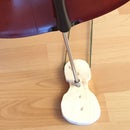Introduction: Easy Wood Shelves (for the Side of a Mezzanine Bed)
A few months ago, I made a mezzanine bed for my younger daughter. Next to it, I wanted to add shelves the same height as the bed and whose highest shelve could be used as a small night stand.
I decided to make something very easy and here I'm sharing this instructable.
Step 1: Materials
- Wood: I chose to use pine wood. It's easy to work with, not expensive and matching with the rest of the furniture I made for my daughter. You will need:
- 4 cleats: the height you'd like and at least 20x20 mm cross-section. In my case, I chose a height of 2 meters, like my mezzanine bed, and with 20x40 mm cross-section
- (optional) 1 cleat: length = same as your shelf length (1 meter in my case) and cross-section something like 20x20 mm
- At least 3 boards with a thickness of 18 mm. Length and width are up to you. I chose to use 7 boards of 1000 x 200 mm that I cut from 2 large 1000 x 800 mm boards.
- Dowels: diameter 8 mm. You'll need 12 of them.
- Shelf pins: 4 x number of adjustable shelves
- Wood glue
- Wood screws: 5 of length 30 mm
- Varnish
Step 2: Tools
- Power saw (if you didn't have the hardware store cut the wood for you)
- Power sander with sanding discs of different grits
- Paint brush
- Power drill
- Clamps
- Ruler, square and pencil to make measures and marks
- Drill stops (highly recommended)
- Doweling jig (highly recommended)
Step 3: Preparing the Wood
Cutting
If you didn't have your wood cut at the right dimensions at your hardware store, then do it yourself with your table or circular saw. Check these lessons on Instructables to learn how to make a straight and accurate cut: https://www.instructables.com/class/Table-Saw-Cla... or https://www.instructables.com/class/Table-Saw-Cla...
Sanding
To the wood smooth, I sanded it 3 times, with decreasing sand paper grits. I used XXX, YYY and ZZZ.
Protecting and varnishing
I applied 3 layers of protection/varnish. Between each layer, I sanded again using a very fine grit.
Step 4: Drilling Holes for the Assembly
The bottom, top and middle shelves will be assembled to the 4 legs to make the structure rigid.
For the bottom and top shelves, assemble them close to or at the edges of your legs. I decided to assemble them 5 cm off the edge of the legs.
For the middle shelf, assemble it at the middle of the legs height.
Mark the assembly locations onto your legs and your shelves sides.
Using your doweling jig, drill holes at these marks.
The size of these holes must be the same as your dowels diameter, which itself depends on the thickness of your shelves. In my case, I used 8 mm dowels.
Step 5: Assembling
Lay 2 legs on the ground.
Put glue on 6 dowels.
Push these dowels into the holes you just drilled into the legs on the ground.
Assemble the top, middle and bottom shelves into these dowels.
Put glue on 6 more dowels.
Push them into the holes on the other side of the shelves.
Assemble the remaining legs into the dowels.
Use clamps to keep everything together while the glue is drying.
Step 6: Drilling the Holes for the Adjustable Shelves
Mark the locations where you'd like to be able to put an adjustable shelf. You need to make sure that you mark them exactly at the same height on each leg, else your adjustable shelf won't be straight.
You can choose as many as you want and as many as you have shelves.
Drill holes at all these marks. Their diameter and their depth must correspond to the diameter and the length of your shelf pin insertable piece. Use a drill stop to make sure you don't drill too deep.
Insert the shelf pins in the holes. Lay your adjustable shelves on top of these pins.
Step 7: Adding a Border to the Top Shelf
The top shelf is at the same level as the top of my daughter's mezzanine bed. It will be used as a night stand. That's why I'm adding a border to it so that objects put on it don't fall if they're pushed too close to this shelf border.
To make that border, I used a cleat with a square cross-section of 20 x 20 mm and with the same length of the shelf.
I drilled a few pilot holes along the length of this cleat piece. I clamped this cleat piece to the border of the top shelf. Then I used wood screws, long enough to go through the cleat and at least half of the shelf (30 mm in my case), and screwed them to assemble the border to the top shelf.

Participated in the
Home Improvement Contest 2017











